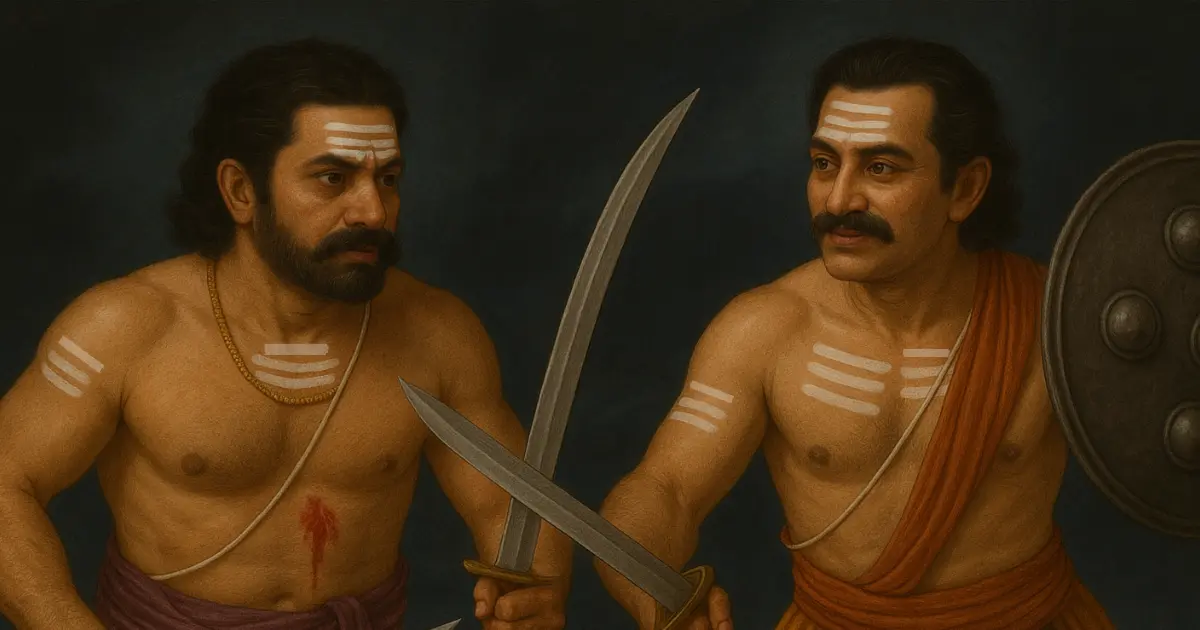Articles > Published Studies > Yenathi: The Clan of the Saivite warrior-saint Yenathi Nathar that traditionally trained the soldiers of the king's army.
Yenathi: The Clan of the Saivite warrior-saint Yenathi Nathar that traditionally trained the soldiers of the king's army.
Published Studies
Featured
May 2, 2025
Introduction
The 10th-century Tamil epic Civaka Cintamani identifies the Yenathi clan as an ancient royal lineage. According to historian Mr. Nellai Nedumaran, Yenathi clan members were among the minor Velir kings who ruled small territories during the Sangam period. Yenathi Nathar, a member of the Yenathi clan and a revered warrior-saint, is mentioned in the epic Periya Puranam. This article is based on the research contributions of Mr. S. D. Nellai Nedumaran, Dr. A. Thasarathan, Mr. S. Ramachandran and Mr. A. Ganesan.

References to the Yenathi clan in Ancient Sanror Documents
Manattu Sundaram, author of Valangai Malai (circa 1600 CE), a Sanror historical ballad, refers to Yenathi Anandan as his teacher. Similarly, Aruthanakutty Adigalar, writing around 1620 CE, names Yenathi Anandan as his guru in the poem Civaka Cintamani Ammanai. The 17th‑century Karumapuram and 17th‑century Thirumurugan Poondi copperplate inscriptions confirm that the Yenathi belonged to the Sanror clan—the ancestors of today's Nadar community.
Yenathi Nathar, a Sanrar warrior and Saivite Saint
The account of Yenathi Nathar in the Periya Puranam further suggests that members of the Yenathi clan were traditionally instructors of battle arts. Yenathi Nathar belonged to the ancient Eela Sanrar (pronounced as Īḻac Cāṉṟār) community, an ancient Sanror subsect, and is counted among the 63 Shaivite Nayanmars [note 1]. Sekkizhar, in his Periya Puranam (also known as Perumān Tiruttonḍar Purāṇam), recounts the rivalry between Yenathi Nathar—a battle‑arts instructor from Eyinanur in the Chola country—and his kinsman Atisuran. Sekkizhar further describes Yenathi Nathar as a holy warrior and glorifies the Yenathi clan’s expertise in martial training with the following verses in Tamil:
Maṉṉarkku veṉṟi vaṭivāṭ paṭaipayiṟṟum taṉmait toḻil viñcai yiltalaimai cārntuḷḷār. Vāḷiṉ paṭaipayiṟṟi vanta vaḷamellām taḷḷāta taṅkaḷ toḻilurimait tāyattiṉ uḷḷāṉ aticūraṉ eṉpāṉ uḷḷāṉāṉ.
The above poetic passage translates to:
He holds the foremost position in the skill and discipline of training the king’s victorious sword‑troops in the battle arts. All the wealth that comes from training those troops belongs to him who, by birthright, inherits your (Yenathi Nathar) ancestral tradition of instructing battle arts—he who is known as Atisuran.
Additionally, Sekkilar uses the term Uravor to address Atisuran, a term used to refer to high-ranking communities or royal clans such as the Velirs. Prior to Sekkizhar, Nambiyandar Nambi—who composed the devotional work Thiruthondar Thiruvanthathi—referred to Yenathi Nathar as Eezhakula Deepan, meaning the light of the Eela clan [note 2].
Sanrors are the ancestors of the Nadars
Ancient Sanror palm leaf manuscripts and copper plate documents prove that the Sanrors are the ancestors of the Nadar community. For instance, the 17th-century Karumapuram copper plate refers to the Sanrors as Saana Kulam, meaning Saana clan in Tamil, and describes a member of the clan as Saana Kula Dheeran, which loosely translates to valiant hero of the Saana clan. The term Saana is the adjectival form of Sanar in Tamil and thus corroborates that the Sanrors are, in fact, the Sanars (Nadars)—as Saana serves as an epithet specifically referring to the Sanrors.
Conclusion
Literary and inscriptional sources affirm that the Yenathi clan played a significant role in military training and were a Sanror subsect. Additionally, these sources highlight the prominence of Yenathi Nathar in Saivite history.
Notes
- The terms Sanrar, Sanravar and Sanar are variants of the term Sanror. This is because of a common linguistic feature in Tamil. For instance, the word Kaṉṟu (meaning "calf") and its variant Kaṇṇu are essentially the same word with different pronunciations. The Nadars today were previously known as Sanars or Shanars.
- As noted by historians and epigraphists, the Eela clan, or Eela Sanrar, and the Ezhava are entirely different communities. Ezhava is a matrilineal left-hand caste from the Indian state of Kerala, whereas Eela Sanrar is a subsect of the ancient right-hand Sanror caste. Ancient Sanror historical documents likewise corroborate this distinction. Right-hand caste members were, in ancient times, regarded as war veterans.
See Also
- From oblivion to light: Reconstructing Nadar community's history through recently discovered ancient documents.
- Connecting the Dots: Understanding the Relationship Between the Noble Sanrors and the Nadar Community.
- Valangai Uyyakondar: A Forgotten Chola Clan Whose Heritage and History Connect to the Nadars of Today.
- Ezhunutruvars: Descendants of the Muvendar Lineage, Renowned for Their Role in Governance and Military Service.
- The Velirs and the Sanrors: Comprehending Their Shared Customs, Heritage, and Royal Legacy as Historically Related Clans.
References
- A. Thasarathan and A. Ganesan. "Māṉavīra Vaḷa Nāṭṭuk Kalveṭṭukaḷ." Tamiḻil Āvaṇaṅkaḷ, edited by A. Thasarathan, T. Mahalakshmi, S. Nirmala Devi, and T. Bhuminaganathan. Tamil Archaeological Book. International Institute of Tamil Studies, Government of Tamil Nadu, 2001, pp. 52-59.
- S. D. Nellai Nedumaran. Tamiḻaka Vēḷir Varalāṟum Āyvum. Tamil Archaeological Book. International Institute of Tamil Studies, Government of Tamil Nadu, 2016.
- S. Ramachandran. Valaṅkai Mālaiyum Cāṉṟōr Camūkac Ceppēṭukaḷum. Tamil Archaeological Book. International Institute of Tamil Studies, Government of Tamil Nadu, 2004.
- S. D. Nellai Nedumaran. "Koṅkunāṭṭu Camutāya Āvaṇaṅkaḷ." Tamiḻil Āvaṇaṅkaḷ, edited by A. Thasarathan, T. Mahalakshmi, S. Nirmala Devi, and T. Bhuminaganathan. Tamil Archaeological Book. International Institute of Tamil Studies, Government of Tamil Nadu, 2001, pp. 95-105.
- V. Nagam Aiya. The Travancore State Manual. Vol. 2, Travancore Government Press, 1906.
- K. R. A. Narasiah. "How the British Took Advantage of a Complex Caste System." The Times of India, 14 Aug 2018.